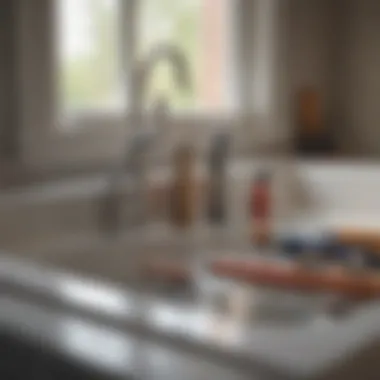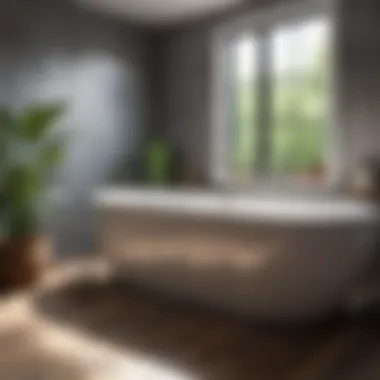Effective Ways to Unclog Your Bathtub at Home


Intro
Addressing a clogged bathtub can be a daunting task for many homeowners. Clogs can lead to frustrating water pooling and, if left unattended, can cause significant plumbing issues. It is essential to understand both the causes and the solutions to effectively maintain your bathtub’s drainage system. Proper knowledge will empower homeowners to tackle this problem with confidence.
In this guide, we will explore practical methods and techniques to resolve a clogged tub, allowing individuals to handle these issues without the need for professional help. Homeowners will benefit from understanding the necessary tools, effective techniques, and preventive measures to keep their bathtubs functioning efficiently. By gaining insight into proper maintenance, one can significantly improve the overall home environment.
The following sections will offer a detailed breakdown of the issues surrounding tub clogs and provide structured strategies to address them. Through this comprehensive approach, we aim to ensure the reader feels equipped to maintain their home plumbing system effectively.
Understanding Clogged Tubs
Clogged tubs can be more than just an inconvenience; they reflect underlying issues in your home’s plumbing system. Understanding the nature of clogs is essential for homeowners who desire a functional and efficient bathroom environment. First, clogs can lead to water retention, promoting unsanitary conditions and potential water damage. Therefore, having knowledge about clogs helps in maintaining the overall health of your home’s plumbing.
Furthermore, recognizing the causes and symptoms of clogs allows homeowners to act promptly. Early detection often means that resolving the issue will be simpler and less costly.
Common Causes of Clogs
Clogs in tubs occur for various reasons. Hair buildup is frequently the primary offender. Over time, strands of hair can tangle with soap residue and other debris, forming a solid mass that obstructs water flow. This issue can be particularly prevalent in homes with long hair or where pets are bathed regularly.
Another significant contributor to clogs is soap scum, a byproduct of soap reacting with minerals in hard water. This can create a thick layer that gradually lines the pipes, leading to blockages over time. Additionally, foreign objects can accidentally fall into the drain, further exacerbating the problem. Some homeowners may overlook the risk that various products, such as bath oils or exfoliating scrubs, can also accumulate and eventually cause a clog.
Identifying Symptoms of Clogs
Recognizing the signs of a clogged tub is the first step toward addressing the problem effectively. One of the most apparent symptoms is slow drainage. If water takes longer than usual to drain after a shower or bath, this can indicate a developing clog. Sometimes, you may notice unusual noises, like gurgling sounds, as air struggles to pass through clogged pipes.
Another key symptom of a clog is a persistent unpleasant odor. Decaying organic material trapped in the pipes can result in foul smells that linger even when the tub is not in use. If you see water backing up around the drain or if multiple fixtures in your home drain slowly, these may be signs of a more widespread plumbing issue.
Effective assessment of these symptoms means better decision-making when it comes to remediation options, ultimately saving time and resources.
Initial Assessment Strategies
Understanding the initial assessment strategies is crucial for effectively addressing a clogged tub. This phase allows the homeowner to diagnose the problem accurately and choose appropriate solutions. Rushing into repairs without proper evaluation can lead to further complications or wasted efforts. Therefore, taking the time to examine the situation thoroughly can save both time and resources in the long run.
Visual Inspection of the Tub
A visual inspection of the tub is the first step in identifying the cause of the clog. Look for any visible debris such as hair, soap scum, or foreign objects that could be obstructing the drain. Often, what appears to be a minor inconvenience could be due to a simple buildup of material. It is important to check around the drain area and inspect the overflow drain, as clogs can develop there as well.
Taking note of any discoloration or rust in the tub could indicate more serious plumbing issues. If the tub appears to be leaking or there are signs of water damage, these should be documented and addressed immediately. This assessment provides context and informs the homeowner of possible underlying issues that may require professional intervention.
Checking Drainage Speed
After the visual inspection, it is essential to check the drainage speed of the tub. This involves filling the tub with water and observing how quickly it drains once the stopper is removed. A normal situation would be for the water to drain quickly and efficiently.
If the water drains slowly, this is a clear indicator of a clog. You might want to perform this test a few times to see if there is any improvement or consistent behavior in the drainage. Note how long it takes for the water to fully exit. Document any patterns observed, such as slower drainage at certain times, as this can provide valuable information regarding the nature of the clog and possible solutions.
Thorough initial assessments are critical. Understanding the exact nature and cause of the clog can directly impact the effectiveness of the chosen repair method.
Essential Tools for the Task


Understanding the tools needed for unclogging a tub is crucial for any homeowner. Having the right equipment can make the task more efficient and less frustrating. More importantly, using proper tools minimizes the risk of damage to plumbing systems, which can be expensive to repair.
When tackling clogs, it is advisable to invest in essential plumbing tools. These tools not only aid in effective clog removal but also enhance the overall maintenance of your plumbing system. Additionally, they can be used for various home repairs beyond just unclogging a tub. Therefore, purchasing quality tools will provide long-term benefits to homeowners.
Must-Have Plumbing Tools
A few specific tools are a must when you consider unclogging a bathtub. The following tools are essential:
- Plunger: A standard toilet plunger is effective for dislodging clogs made up of hair and soap. Make sure it has a flange for better sealing around the drain.
- Drain Snake: This tool is vital for reaching deep clogs. A manual or an electric drain snake can cut through blockages of hair and sediment that a plunger cannot handle.
- Pipe Wrench: Useful for turning and twisting pipes, a pipe wrench can assist in loosening fittings around the area.
- Basin Wrench: This tool helps in tight spaces often found under sinks.
- Hair Catcher: This preventive tool can be placed in the drain to catch hair and debris before it builds up.
By having these tools ready, homeowners can tackle most tub clogs independently, saving both time and money.
Safety Gear and Equipment
Safety should always be a priority when working on plumbing tasks. The right safety gear protects you from potential hazards. Therefore, here are essential items to consider:
- Gloves: Wear rubber gloves to protect hands from chemicals or sharp objects.
- Safety Glasses: Protects eyes from splashes of drain cleaners or other tools.
- Face Mask: If using chemicals, wearing a mask can help avoid inhaling harmful fumes.
- Knee Pads: These can provide comfort when kneeling for extended periods.
Investing in safety gear not only ensures personal safety but also enhances focus on the task, allowing for more effective results.
"Proper tools and safety equipment can transform a daunting plumbing task into a manageable project at home."
DIY Techniques for Unclogging
DIY techniques for unclogging a tub are essential for homeowners who want to maintain their plumbing without the need for professional services every time an issue arises. Understanding these methods can save time and money while ensuring that the drainage system remains functional. With the right approach, homeowners can often resolve clogs quickly and effectively, avoiding unnecessary plumbing bills.
Using a Plunger
A plunger is a basic yet effective tool in unclogging tubs. The functionality of a plunger relies on creating suction and pressure, which helps dislodge debris that restricts water flow. When using a plunger,
- Ensure a good seal around the drain.
- Use a consistent up-and-down motion, applying firm pressure to allow the suction to work effectively.
- Repeat as necessary until the clog is dislodged or removed.
It is best to cover the overflow drain with a cloth to improve effectiveness. This will limit the air escaping, thereby maximizing the pressure generated.
Employing a Drain Snake
A drain snake, often known as a plumber's auger, is another valuable technique for DIY unclogging. This tool is designed to reach deeper into pipe systems, giving access to clogs that a plunger may not break free. Here’s how to use it correctly:
- Insert the snake slowly into the drain until you feel resistance.
- Rotate the handle to engage the clog.
- Push and pull gently to break up the debris.
Be cautious while using a drain snake, as it may scratch or damage pipes if used aggressively. Familiarity with the construction of your plumbing system can help in avoiding such damage.
Chemical Drain Cleaners
Chemical drain cleaners can be an effective method for clearing stubborn clogs, especially those caused by grease or soap. However, these should be used carefully. Some important points to consider include:
- Read the instructions on the product label carefully.
- Choose a cleaner that is suitable for the materials in your plumbing (some cleaners can be too harsh for certain types of pipes).
- Follow all safety precautions, such as wearing gloves and eye protection.


If chemical drain cleaners do not resolve the clog, it may be a sign of a more significant issue within the plumbing system. In such cases, further assessment or professional intervention may be warranted.
Remember, each technique has its benefits and limitations. Being knowledgeable about these methods allows homeowners to tackle plumbing issues with confidence.
Preventive Measures to Avoid Clogs
Preventive measures play a crucial role in maintaining the functionality of your bathtub’s drainage system. Addressing clogs before they become significant problems can save time, effort, and money. Routine checks and simple practices can greatly reduce the risk of blockages in your tub.
Regular Cleaning Practices
Regular cleaning is fundamental in preventing clogs. Hair, soap residue, and even mineral deposits can accumulate in the drain over time. It is important to establish a cleaning schedule. For instance, using a simple solution of vinegar and baking soda can effectively help in breaking down any deposits or buildup in the drain. Pour half a cup of baking soda followed by half a cup of vinegar. Allow it to sit for about 30 minutes, then flush with hot water. This practice not only keeps the drains clear but also reduces unpleasant odors that can arise from trapped debris.
Follow these steps for effective routine maintenance:
- Remove Hair: After each shower, inspect and remove any hair trapped in the tub or drain.
- Clean the Drain Cover: Ensure that the drain cover is free from grime and hair.
- Use Hot Water: Regularly run hot water down the drain for a few minutes to help dissolve buildups.
- Create a Cleaning Schedule: Establish a weekly or monthly routine.
By implementing these simple cleaning practices, you will significantly enhance the longevity and efficiency of your tub's drainage system.
Use of Drain Covers
Using drain covers is another effective strategy to prevent clogs. Drain covers act as a barrier that stops larger debris from entering the drain. They can trap hair and other materials that often lead to blockages. Invest in a high-quality drain cover that fits snugly in your bathtub. This small but effective measure can save you from frequent clogging issues.
Some things to consider about drain covers include:
- Type of Cover: Choose a cover that allows water to flow efficiently while catching debris.
- Material: Select a drain cover made of durable material to ensure longevity.
- Maintenance: Regularly clean the drain cover to avoid accumulation of debris on its surface.
Using drain covers can dramatically reduce the amount of debris that makes its way into your plumbing system. This simple solution offers substantial protection against clogs while making maintenance easier.
Remember, proactive maintenance is key. By integrating regular cleaning and the use of drain covers into your routine, you significantly minimize the risk of clogged tubs, ensuring a more pleasant experience when using your bath space.
When to Call a Professional
Dealing with a clogged tub can be a frustrating experience. In some cases, homeowners may successfully address the issue using DIY methods. However, there are instances when calling a professional is necessary. Recognizing the signs that indicate the need for expert help can save time, effort, and money in the long run.
Signs of Major Plumbing Issues
When a clog occurs, it can sometimes be a minor setback easily remedied. But certain symptoms suggest a deeper problem at hand. Pay attention to the following signs:
- Frequent Clogs: If your bathtub consistently clogs, it may not just be a single incident. This could indicate problems further along your plumbing system.
- Multiple Drains Affected: If other fixtures within your home, like sinks or toilets, are also backing up or draining slowly, there might be a larger blockage in the main sewer line.
- Water Backflow: Any instance of water flowing back up from the drain can signal serious issues needing immediate attention. This can often lead to significant water damage or health hazards.
- Unusual Noises: If you hear gurgling sounds in drains or water pipes when your tub drains, it is an indicator of air trapped in plumbing, threatening functionality.
Recognizing these symptoms early helps identify when it's critical to consult professionals with the right tools and expertise to handle complicated plumbing issues.
Understanding Cost Considerations
Cost is often a significant factor when deciding whether or not to call a plumbing service. There are a few aspects to consider:
- Service Fees: Professional plumbers typically charge for their services based on the nature of the work and time spent. It may include an hourly rate and sometimes additional costs for specific tools or materials.
- Long-Term Savings: While initial costs may seem hefty, hiring a professional can prevent recurring issues. A permanent solution can avoid more severe problems that result in larger repairs later on.
- Property Value: Poorly handled plumbing problems can lead to damage that negatively impacts real estate value. Ensuring the plumbing system is in optimal condition maintains your property's appeal.


Ultimately, while the cost might deter some, it is vital to weigh the potential risks of not getting professional assistance. A wise approach considers both immediate needs and future implications.
Long-term Solutions for Clogged Tubs
Addressing a clogged tub is often an urgent task. However, thinking long-term can save time, money, and inconvenience. Long-term solutions focus on preventing clogs before they start. They ensure the bathtub drainage system remains functional over years. Homeowners should prioritize these considerations to create a sustainable environment in their bathrooms.
Effective drainage systems will improve overall water flow. Upgraded bathtub components directly contribute to this result, making maintenance easier and more efficient over time. Ultimately, these long-term solutions can provide peace of mind while maintaining property value.
Installation of Effective Drainage Systems
New drainage systems may seem unnecessary until a major clog occurs. Installing effective drainage systems is an investment that can significantly reduce future plumbing troubles. These systems should be designed to handle the typical flow of water associated with everyday use.
When planning for this installation, consider the following:
- Pipe Diameter: Wider pipes allow for better flow, reducing the likelihood of clogs.
- Material Quality: Using high-quality materials, such as PVC or ABS, can increase durability.
- Slope Angle: Ensuring proper slope can facilitate faster drainage, which prevents pooled water and clog build-up.
Before making changes, consulting with plumbing professionals can be beneficial. They can provide insights based on your specific home configuration and local plumbing codes. Also, consider checking resources like Wikipedia for foundational knowledge on drainage systems.
Upgrading Bathtub Components
Sometimes, the issue lies within the bathtub components themselves. Upgrading these parts can significantly enhance drainage performance. If old or inefficient components are still in use, they can contribute to clogs over time. Consider replacing:
- Drains: New, high-efficiency drains can provide better water flow.
- Overflow Assemblies: Outdated parts can interfere with drainage and lead to backflow.
- Trim Kits: Functional design upgrades can improve efficiency as well.
Investing in good quality upgrades can result in decreased maintenance needs. Furthermore, it can improve the overall aesthetic of your bathroom. It is worth researching options and selecting components that complement your home's decor while enhancing functionality.
"Preventive measures for maintaining a clog-free tub involve consistent monitoring and proactive upgrades."
With these long-term solutions, homeowners will find it easier to manage plumbing issues. By taking decisive action, they can foster a healthier plumbing system, thus enhancing the comfort of their living space.
Final Thoughts on Tub Maintenance
Effective tub maintenance is critical for ensuring that your drainage system remains functional. Over time, debris, hair, and soap scum can accumulate, leading to clogs that can interrupt the flow of water and create inconvenience. The relevance of maintaining your tub cannot be overstated. A well-maintained tub will not only enhance your bathing experience but also prolong the lifespan of the plumbing components.
Regular Maintenance Routines
Implementing regular maintenance for your tub involves simple yet effective routines. One of the most fundamental practices is to clean the drain area frequently. Use a soft brush or cloth to clear away any visible buildup around the drain. Additionally, a mixture of hot water and vinegar can be poured down the drain once a month. This can help dissolve some of that stubborn grime.
Furthermore, check for loose or damaged parts of the bathtub regularly. If you notice any wavering in the drain cover or any cracks in the tub, address these issues immediately. Ignoring these can lead to more significant plumbing problems.
- Habitual cleaning: Wipe down the bathtub after each use.
- Drain inspection: Monthly checks can preempt potential clogs.
- Remove hair: Utilize a drain strainer to capture hair before it reaches the drain.
Maintaining a Healthy Plumbing System
A healthy plumbing system contributes significantly to overall tub maintenance. Regular inspections of your plumbing can detect issues before they become significant headaches. One must pay attention to the sounds of gurgling pipes, which may signify venting issues.
Moreover, ensure that your plumbing is adequately vented. An improperly vented system can lead to slow drainage, which is often misinterpreted as a clog. It is advisable to learn about the layout of the plumbing system in your home. This knowledge can aid in identifying potential problem areas and allowing you to take action when necessary.
"Proper plumbing maintenance not only prevents clogs but can also avoid costly repairs down the line."
Utilizing biodegradable drain cleaners can be a proactive choice for maintaining your plumbing. Chemical cleaners can erode your pipes over time, while biodegradable options break down naturally. Furthermore, consider scheduling professional inspections annually. This ensures your plumbing system is always in optimal condition, promoting longevity and functionality.
By adopting thorough routines and understanding your plumbing, you enhance not only your bathing experience but the integrity of your home’s plumbing as a whole.







